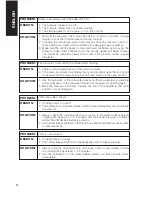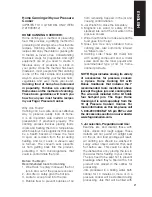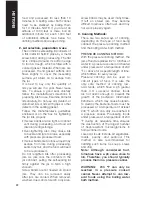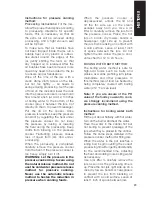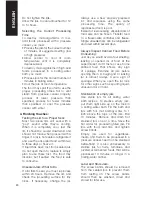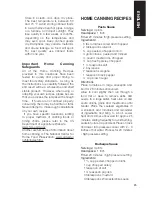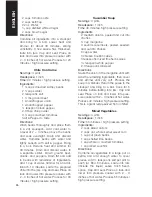
15
capacity with beans and legumes,
as these foods tend to expand
and froth during cooking.
• Clean out any foreign particles. Rinse
them with warm water.
• Soak beans in four times their volume
of warm water for at least four hours
before cooking, or if you prefer, leave
them to soak overnight. Do not add salt
to the water as this hardens the beans
and prevents absorption of water.
• Do not soak dried split lentils.
• After soaking, remove floating beans
and shell.
• Strain the water off the beans.
• Rinse in warm water (this also applies
to dried split lentils).
• Put the beans or legumes in the
pressure cooker. Add three cups
of water for each cup of beans or
legumes. Do not add salt; beans and
legumes should be seasoned after
cooking.
• Add a tablespoon of vegetable oil for
each cup of water to eliminate the
foam they produce.
• To add more flavor, cook beans or
lentils with some bay leaves and a
small peeled onion embedded with
two cloves of spice.
• After the cooking time is up, use the
natural release method to allow the
pressure to decrease naturally.
• Cooking times may vary depending
on the quality of the beans or other
legumes. If after the recommended
cooking time the beans are still hard,
continue cooking them with the lid off.
If necessary, add water.
• A cup of beans or other legumes yields
approximately two cups when cooked.
BEANS AND LEGUMES
APPROXIMATE
COOKING
TIME
Azuki beans
4-5 minutes
Beans, white
5-7 minutes
Beans, scarlet, red
10-12 minutes
Beans, black
8-10 minutes
Beans, colored
4-6 minutes
Pigeon peas
7-9 minutes
Chick peas
10-12 minutes
Lentils, red
7-9 minutes
Lentil soup
8-10 minutes
Lentils, green
8-10 minutes
Grains
•
WARNING:
Never fill the pressure
cooker to more than half its capacity
with grains, as these foods tend to
expand and froth during cooking.
• Clean out any foreign particles. Rinse
them with warm water. Soak grains, in
four times their volume of warm water
for at least four hours before cooking
them, or if you prefer, leave them to
soak overnight. Do not add salt for
this will harden grains and prevent
them from absorbing water.
• Do not leave rice to soak.
• After soaking remove floating grains
or shells.
• Drain the water off the grains.
• Rinse grains in warm water (this also
applies to rice.)
• Cook each cup of grain in the quantity
of water indicated in the recipe or on
the package.
• If you prefer, add salt to taste.
• After the cooking time is up, use the
natural release method to allow the
pressure to decrease naturally.
• Cooking times may vary depending
on the quality of the grains. If after the
recommended cooking time the grains
are still hard, continue cooking them
with the lid off. If necessary, add water.
•
A cup of grains expands to
approximately two cupfuls when
cooked.
GRAINS APPROXIMATE
COOKING
(1 cup)
WATER QUANTITY
TIME
Rice, basmati
1 ½ cups
5-7 minutes
Rice, brown
1 ½ cups
15-20 minutes
Rice, long grain
1 ½ cups
5-7 minutes
Rice, wild
3 cups
22-25 minutes
ENGLISH




















